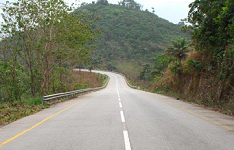For truck driver Joseph Turay, navigating the 120 km Matotoka-Sefadu road in northeastern Sierra Leone used to be a nightmare. On average, he spent between five hours to one day on the road, which was last properly repaired nearly half a century ago.
Joseph and other drivers watched goods perish and vehicles destroyed before they reached their destination. The rainy season brought more hazards. Large vehicles often overturned due to the potholed road surface, leading to fatalities and damage to goods. The remnants of overturned vehicles carrying cement, petrol, food or mining equipment were a common sight at the side of the road.
At the height of the rains, drivers could spend as much as three days on the road and few vehicles survived unscathed on the Matotoka-Sefadu road, which is a strategic artery connecting the administrative districts of Tonkolili and Kono in Sierra Leone. The road also forms part of the major highway linking Sierra Leone to Guinea and Liberia.
Turay, who is vice-chairman of the Matotoka Drivers Association, now has reason to smile. Support from the African Development Bank has helped to rehabilitate and expand the road, easing the movement of goods and people in the northern and eastern provinces of Sierra Leone.
From one day, it now takes two hours or less to travel the road. The road is safer and accidents have been minimized. Perishable products now get to their destination in good time,” Turay said, surrounded by a sea of excited drivers.
The road’s rehabilitation has also eased the transportation of minerals, including diamonds and iron ore, to the Sierra Leonean port of Nitti, thereby boosting mining activities and exports.
As lead financier, the Bank provided an African Development Fund loan and grant of $34 million, covering about 77 percent of the total project cost, excluding resettlement and compensation costs.
The Bank’s support covered 70 km of the road, generating socio-economic benefits to communities along the route.
The communities now have better access to health facilities, farms, markets and schools. Women stall holders along the roadside have reported an uptick in business. What’s more, bus services between the capital Freetown and Sefadu have resumed.
“Sales were low before the road was restored. I earn at least twice more than before,” said Hauwa Sesay, chairwoman of Matotoka Market.
As part of the project, new classroom blocks were constructed in three existing schools to increase enrolment and reduce overcrowding in classes.
“The new classroom building in my school has made learning more enjoyable. My friends who couldn’t come to school have now returned,” said Abass Conteh, the head boy of the Roman Catholic Primary School in Makali, where a classroom block was built.
The National Minerals Agency estimates that diamond exports have increased since the road rehabilitation was completed in 2018, with improved access to mining sites in diamond-rich Kono district.
Officials say licenses for mining have leaped with renewed investor interest and the agency has now established an office in Kono to improve regulation and governance.
For now, Turay and the other drivers are still enjoying the novelty of the newly resurfaced road. As he starts up his vehicle to zoom off on another journey, his fellow drivers see him off with a cheer.

